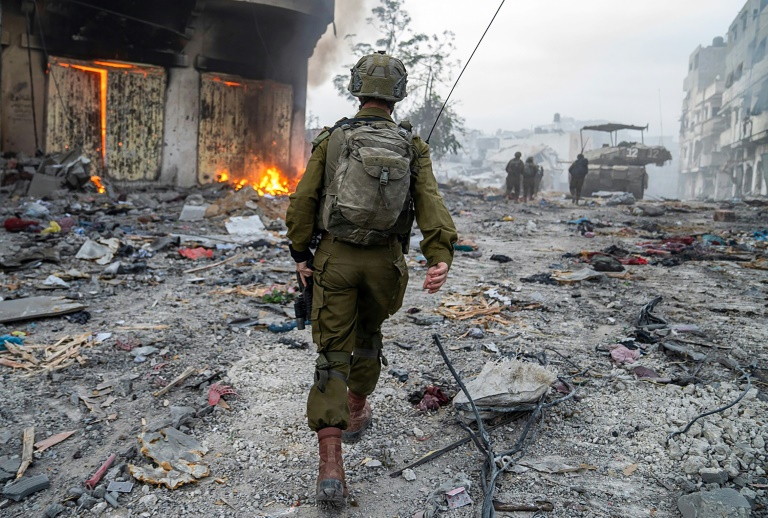Israel trains fire on south Gaza, as Biden urges caution

Israeli soldiers operate in the Gaza Strip, in a picture released by the army on December 22, 2023
– Israel said its armed forces were increasingly focused on Hamas targets in south Gaza Sunday, as the United States again pressed its ally to do more to protect Palestinian civilians.
Signalling a pivot after weeks of intensive fighting around Gaza City, the Israeli army said troops were now looking to the Hamas stronghold of Khan Yunis and elsewhere in the south.
The refugee camp-turned-city is the birthplace and powerbase of Yahya Sinwar, Hamas’ leader in Gaza and the man Israel holds most responsible for the October 7 attack that sparked the war that has convulsed the region.
Hamas militants streamed across the Gaza border on October 7 and attacked southern Israeli communities, killing about 1,140 people, mostly civilians, according to an AFP tally based on Israeli figures. They also seized around 250 hostages, of whom 129 remain in Gaza.
In response, Israel vowed to crush Hamas and launched an air, land and sea offensive on Gaza. The Palestinian territory’s Hamas government says the war has killed more than 20,000 people, mostly women and children.
The Israeli army said nine soldiers were killed in Gaza on Saturday, bringing to 152 its overall death toll in the territory since the ground assault began on October 27.
While the Israeli army would continue operations across Gaza, military spokesman Jonathan Conricus indicated forces were close to having operational control in north Gaza.
Now, he said, “we focus our efforts against Hamas in southern Gaza”.
In central Gaza, rescuers scrambled overnight to pull people from a destroyed residential building in the city of Deir al-Balah.
“I was praying when a huge explosion occurred, and rubble fell on us. I didn’t know what happened,” said Yazan Moqbel, a wounded man whose sister was still under the rubble.
Israel denies directly targeting civilians and says the war against Hamas is vital to ensure October’s shock raids on farms, villages and kibbutzim in Israel can never be repeated.
– ‘We want a ceasefire’ –
Early on Sunday, Hamas said new strikes had hit Jabalia and Khan Yunis.
Nearly 80 percent for Gaza’s 2.4 population has been displaced by the fighting, the UN estimates.
Many from the north have fled to the relative safety of the south, only to be caught up in the war for a second time.
Against this backdrop, US President Joe Biden said he had another “long talk” with Israel’s hawkish prime minister, Benjamin Netanyahu.
The White House said the discussion focused on the “objectives and phasing” of Israel’s military operation, as well as “the critical need” to protect civilians.
Israeli officials gave a terse account of the call, saying Netanyahu “made it clear that Israel would continue the war until all of its goals have been achieved”.
Netanyahu, Israel’s longest-serving premier, has had testy relations with a string of US presidents.
But disagreements over how the Gaza war is being waged, when it will end, and what happens the day after, have strained ties ever further.
On Friday, the United States allowed the passage of a UN Security Council resolution that effectively called on Israel to allow “immediate, safe and unhindered” deliveries of life-saving aid to Gaza “at scale”.
– ‘Lost contact’ –
World powers had wrangled for days over the wording, and at Washington’s insistence toned down some provisions — including removing a call for a ceasefire.
UN Secretary-General Antonio Guterres has accused Israel of “creating massive obstacles” for aid deliveries.
South Gaza is the main avenue for humanitarian relief to enter the territory.
What little aid arrives into the territory comes, for the most part, across the Egyptian border near Rafah.
For Palestinians in that southern city, the prospect of aid alone was not enough.
“We don’t want food, we want a ceasefire,” said Mahmud al-Shaer.
Ahmad al-Burawi, who was displaced from Beit Lahia further north, added: “We just want to return to our lands, that’s all. We want a solution” to end the war. “People are dying.”
Israelis, including friends and relatives of the 129 captives still believed held in Gaza, demonstrated again on Saturday in Tel Aviv.
Hamas’s armed wing said it “lost contact” with militants tasked with guarding five of the hostages, including three elderly men who appeared in a hostage video the group released this week.
“We believe that those hostages have been killed” in Israeli strikes, said spokesman Abu Obeida without providing evidence.
– Ship attacks –
Talks aimed at resuscitating a truce and prisoner swap appeared to be stalled.
An earlier truce allowed 80 Israeli hostages to be released in exchange for 240 Palestinian prisoners, but ended after one week.
The army says about 700 Hamas and Islamic Jihad “terrorist operatives” have been captured since the war began.
Far from Gaza, new attacks on shipping routes showed the war is already spilling over into the broader region.
Maritime agencies said a drone strike damaged a chemical tanker in waters off Veraval, India.
There was no claim of responsibility, but the Pentagon said it was a “one-way attack drone fired from Iran”.
The United States blamed Yemen’s Iran-backed Huthi rebels for firing drones and missiles at a US warship and two other vessels around the Red Sea.
US Central Command said four unmanned aerial drones had targeted the USS Laboon, but had been shot down.
The US military also said an Indian-flagged crude oil tanker in the Red Sea was hit and sent out a distress call.
Iran’s deputy foreign minister, Ali Bagheri, on Saturday denied Iran was orchestrating the campaign, saying the Huthis act on their “own decisions and capabilities”.
There also have been cross-border skirmishes between Israeli forces and Lebanon’s powerful Hezbollah movement which, like Hamas, is backed by Iran.
